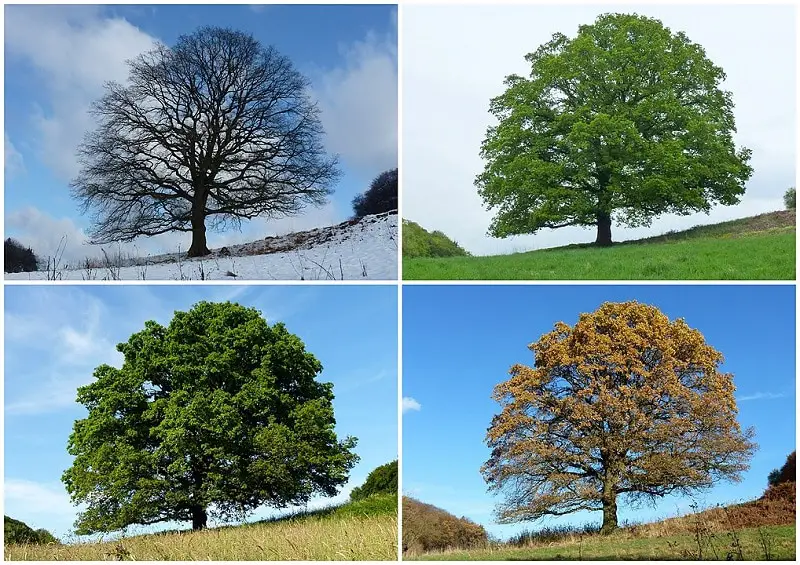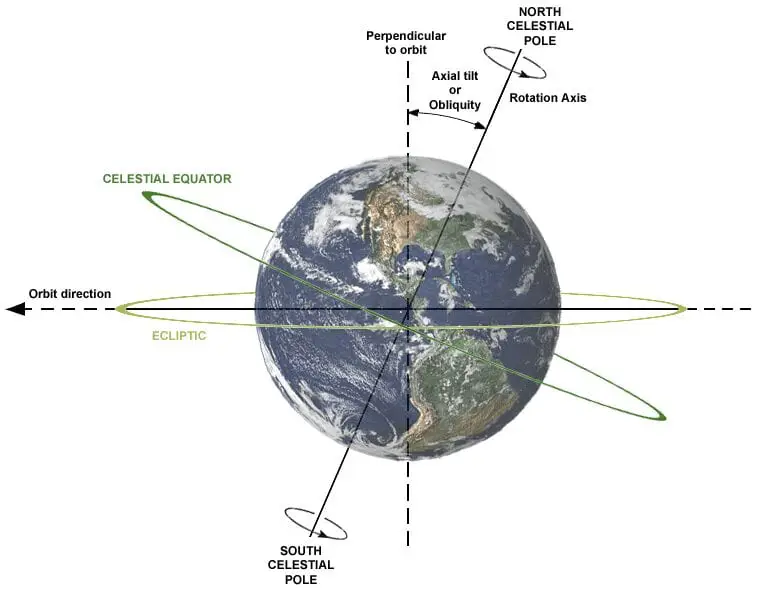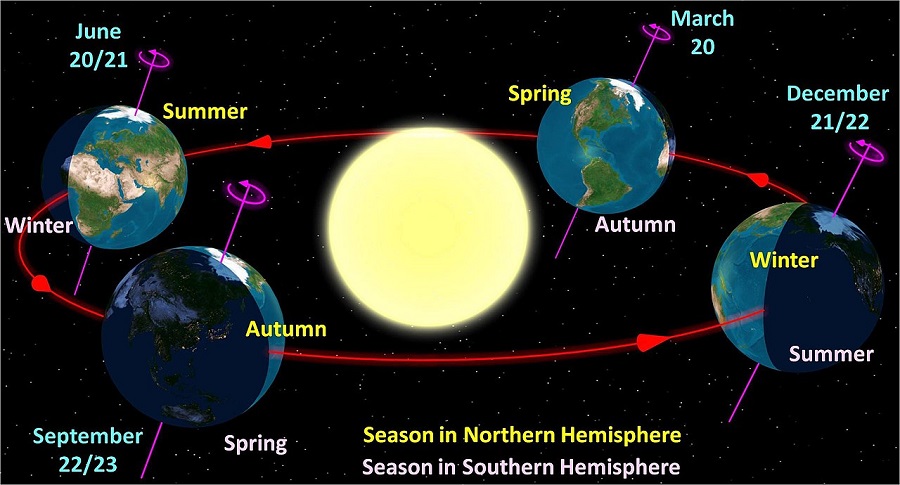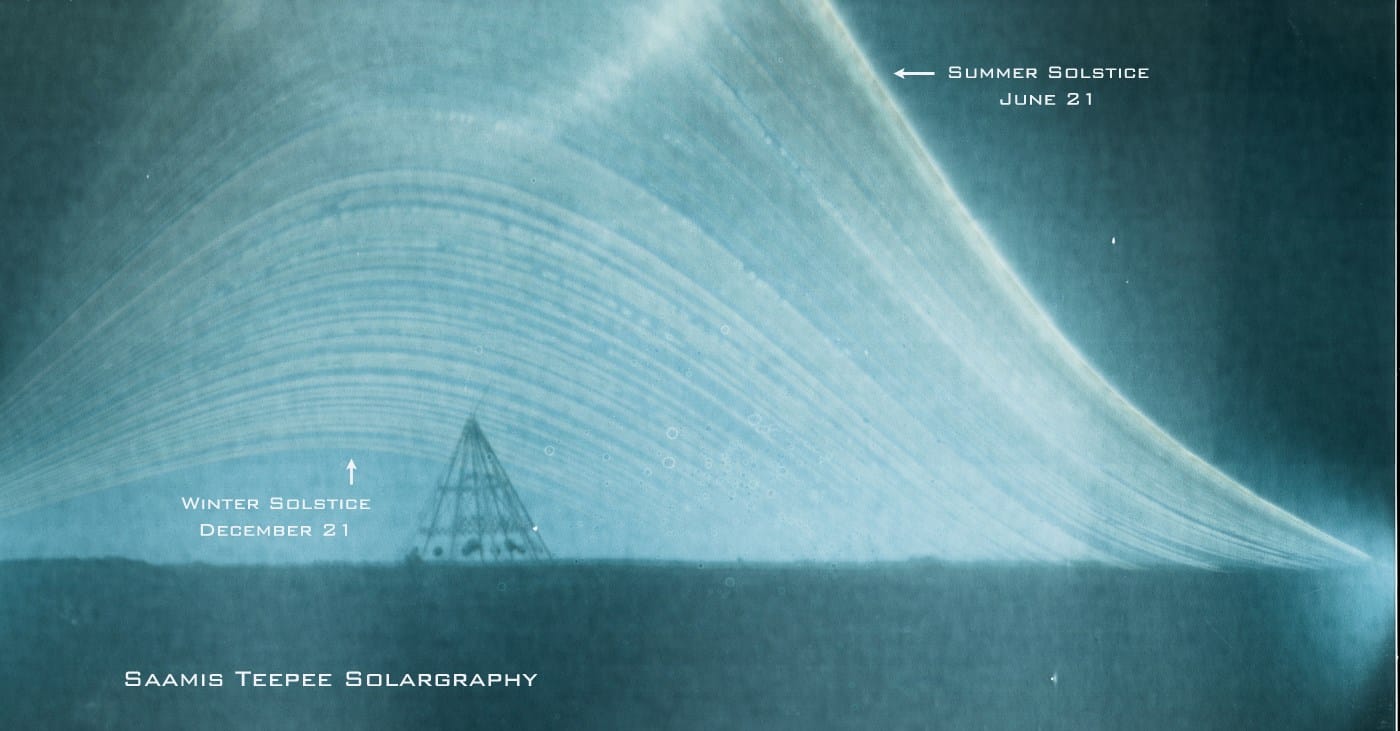December Solstice marks the arrival of the first day of winter in the northern hemisphere, therefore, known as Winter Solstice or Hibernal Solstice, will occur on Friday, December 22, 2023, at sharp 03:28 Universal Coordinated Time (UTC). Not to mention, this astronomical event will also mark the darkest as well as the shortest day of the year in the northern hemisphere.
On the other hand, for the people living in the southern hemisphere, this solstice marks the arrival of the first day of summer, therefore known as the Summer or Estival Solstice. Similarly, this astronomical event will mark the brightest as well as the longest day of the year in the southern hemisphere.
To summarize, one can say that the meaning of solstice changes depending on the fact that at which side of the hemisphere you live upon. Moving ahead, in this exclusive article, we will talk about the fact why December Solstice i.e winter solstice in the northern hemisphere is the summer solstice in the southern hemisphere.
Or, the questions like that is December Solstice actually the official first day of winter or mid-winter? Therefore, in order to get the answer to questions like these, I would suggest you stick with me till the end. Let’s dive right in!!!
What is Solstice?
There are two ways to define the meaning of solstice. These are meteorological and astronomical definitions of Solstice. Right now, I am going to explain it on the basis of astronomy. But that doesn’t mean I won’t be explaining it on the basis of meteorology. We will talk about it in a later section.
So, moving ahead, according to the astronomical definition of solstices, this is a natural event during which one of the hemispheres is at the maximum tilt away from or towards the sun. And, when this happens, the sun appears to stand still and reverses its direction. In layman, Solstice is a day that occurs due to the sun’s changing path.
Highly Recommended: Equinox vs Solstice – What’s the Difference?
Four Seasons
In case you don’t know, there are generally four seasons that occur on earth. These are summer, winter, autumn, and spring. Just like the summer and winter solstice is responsible for the arrival of summer and winter seasons on earth. In a similar way, the spring & fall equinox is responsible for the arrival of spring and autumn seasons on earth.

To summarise, each year earth experiences 2 solstices (summer and winter) and 2 equinoxes (spring and fall) that help us to understand the patterns related to the changing seasons.
Now, the question arises that why there is a mismatch between the north and south. To put it differently, why when there is the winter solstice in the northern hemisphere? At the same time, there is the summer solstice in the southern hemisphere. Let’s Find out!!!
Editor’s Choice: Seasons in Northern Hemisphere & its Bizarre Consequences
Thanks to Earth’s Tilt, We See Solstices

Well, there is a small correction here. Not only do we see solstices because of the earth’s tilt. We see equinoxes too. Moving ahead, just because the earth has an axial tilt of 23.4 degrees, there is a mismatch between the northern and southern hemispheres.
In fact, Kepler’s law also contributes to the formation of the different seasons across the globe. YES, YES, the same Kepler’s law that states that all the planets in the solar system revolve around the sun in an elliptical orbit.
However, Kepler’s law contribution can’t be compared to the role played by the earth’s tilt. I mean, if I say in terms of approximated ratios. Then it will be like 90:10.
| Basis of Comparision | Northern Hemisphere | Southern Hemisphere |
| March Equinox | In the northern hemisphere, it marks the first day of spring, therefore, Spring or Vernal Equinox. | In the southern hemisphere, it marks the first day of fall, therefore, Fall or Autumn Equinox. |
| June Solstice | It marks the first day of summer, therefore, Summer Solstice. | It marks the first day of winter, therefore, Winter Solstice. |
| September Equinox | Marks the first day of fall, therefore, Fall Equinox. | Marks the first day of spring, therefore, Spring Equinox. |
| December Solstice | It marks the first day of winter, therefore, Winter Solstice. | It marks the first day of summer, therefore, Summer Solstice. |
December Solstice – First Day of Winter in the Northern Hemisphere

As you already know that a solstice is a natural event during which one of the hemispheres is at the maximum tilt away from or toward the sun. Moreover, you also know that there are two types of Solstices.
These are June Solstice and December Solstice. So, how to define June solstice or December Solstice? OKAY, let me rephrase my question for you!!! What’s the difference between June and December solstice? ANY GUESS?
See, the only difference between them is that during the June solstice, the north pole of the earth is at its maximum tilt towards the sun, hence known as the Northern Solstice. On the other hand, during the December solstice, the south pole is at its maximum tilt towards the sun, hence known as the southern solstice.
December Solstice – Southern Solstice

During December Solstice, the south pole of the earth is at its maximum tilt towards the sun. Therefore, as a result, half of the earth’s surface (northern hemisphere) receives minimum sunlight.
Hence, marking the darkest as well as the shortest day of the year in the northern hemisphere. That’s why the December Solstice aka Southern Solstice is officially known as the winter solstice in the northern hemisphere.
In addition, not only the sun’s orbital path across the sky will be as low as it can be. The sun will also enter the Tropic of Capricorn on the eve of December Solstice. And with that, days get longer and longer after the arrival of the winter solstice. That’s why the winter solstice in the north is also known as the mid-winter.
Winter Solstice – First Day of Winter or Midwinter?
Now is the time that we should talk about the meteorological definition of the winter solstice. Well, technically speaking, if we go by the meteorological definition of the winter solstice, it marks the end of half of the winter or winter season, hence mid-winter.
However, on the other hand, if we go by the astronomical definition of the winter solstice, it marks the arrival of the first day of winter. Therefore, the question arises that why we have two different definitions for a single event. More importantly, which one of these is the correct one? Let’s find out.
Let’s Go Back in Time
Before the arrival of the scientific revolution, humans didn’t know how to calculate the change in the season in terms of astronomical calculations. WHY? Because they didn’t have the telescope to do such nasty observations.
Therefore, what they used to do is to calculate the change in season as humanly as possible. With time, early humans understood that the sun seems to cross over the horizon after a fixed interval of time. Additionally, they also understood the pattern of the annual temperature cycle.
In other words, what early humans used to do is to calculate the relative things, like what they felt and observed with the naked eye, which is in fact in the modern notation known as the meteorological definition of winter solstice or simply meteorological winter.
Editor’s Choice: Full Moon Calendar 2023 (Dates & Names – Northern Hemisphere)
On the other hand, what our astronomers and scientists calculate with their super-sophisticated technology is defined as the astronomical definition of winter solstice or simply astronomical winter. Therefore, to conclude, I would say that both definitions are correct in their own sense. Hence, as a result, some people define winter solstice in the northern hemisphere as the first day of winter.
On the contrary, some people define it as the end of half of the winter or winter season. Hence mid-winter. Not to mention, the meteorological seasons always arrive approx 20 to 21 days before the arrival of astronomical seasons. To understand it more clearly, refer to the below table.
Meteorological vs Astronomical Seasons
| Seasons | Meteorological Season Dates | Astronomical Season Dates |
| Spring Equinox | Wednesday, 1 March 2023 | Monday, 20 March 2023 |
| Summer Solstice | Thursday, 1 June 2023 | Wednesday, 21 June 2023 |
| Autumn Equinox | Friday, 1 September 2023 | Saturday, 23 September 2023 |
| Winter Solstice | Friday, 1 December 2023 | Friday, 22 December 2023 |
How Short is the Shortest Day of the Year in the Northern Hemisphere?

How short is the shortest day of the year in the northern hemisphere simply depends on the fact that how close you are residing to the north pole. In other words, the closer you reside to the north of the arctic circle towards the north pole, the thinnest hours of daylight you will receive.
According to the data released by the Finnish Meteorological Institute, during the 2015 winter solstice, the Russian port city of Murmansk received zero hours of daylight. Similarly, Copenhagen received approximately 7 hours and 1 minute of daylight. Rome received 9 hours and 7 minutes of daylight. Los Angeles received 9 hours and 53 minutes of daylight.
Not to mention, my home i.e New Delhi received 10 hours and 19 minutes of daylight. To summarize, if we talk about the whole of the northern hemisphere as one, the shortest day of the year in the northern hemisphere received an average of 9 hours of daylight. Don’t forget, the closer you are to the north pole, the thinnest hours of daylight you will receive.
When is Winter Solstice in Northern Hemisphere?
In 2023, the December Solstice i.e the first day of winter in the northern hemisphere will occur on Friday, December 22, at a sharp 03:28 Universal Coordinated Time (UTC). It is the time when the sun will be lowest in the sky, therefore, marking the darkest as well as the shortest day of the year in the earth’s northern areas.
Not to mention, this astronomical event will occur at the same moment for all of us. In other words, whether you are living in Australia (i.e in the southern hemisphere), or in London (i.e in the northern hemisphere), it would be a moment of joy for all of us at the same instant.
Editor’s Choice: Seasons in Southern Hemisphere & its Bizarre Consequences
That’s it for this post. If you like this article, share it if you like, like it if you share it. You can also find us on Mix, Twitter, Pinterest, and Facebook. Hey man, If you have come this far, do give us feedback in the comment section. It would make my day. You can also make a donation. Your donations will help us to run our website and serve you BETTER. Cheers!!!
You might also like:
- March Equinox 2023 – First Day of Spring in Northern Hemisphere
- March Equinox 2023 – First Day of Fall in Southern Hemisphere
- June Solstice 2023 – First Day of Summer in Northern Hemisphere
- June Solstice 2023 – First Day of Winter in Southern Hemisphere
- September Equinox 2023 – First Day of Fall in Northern Hemisphere
- September Equinox 2023 – First Day of Spring in Southern Hemisphere
Thank you very much for these posts. I learn a lot. It doesn’t feel “dumbed down” but just explained more clearly than when I was in school. Look forward to reading more.
Welcome Elizabeth, keep visiting us…!!!